HI5017 Management Accounting Case Studies: Cost Analysis and Decisions
VerifiedAdded on 2023/03/20
|13
|3767
|37
Case Study
AI Summary
This case study analyzes the costs associated with starting and running a childcare business. It explores variable, fixed, and operating costs, and examines different options for laundering clothes, including outsourcing and purchasing appliances. The analysis includes detailed calculations of costs for each option, helping the business owners make cost-effective decisions. The case study also considers the implications of hiring an employee, including salary, benefits, and the impact on revenue and profit. Finally, it evaluates the considerations for moving the daycare to a new premise, comparing the costs and benefits of operating from home versus a new location, and making recommendations based on profit maximization and compliance with regulations. The analysis provides comprehensive financial insights to guide the business's operational and strategic decisions, including the impact of employee hiring and relocation on the financial performance of the business.
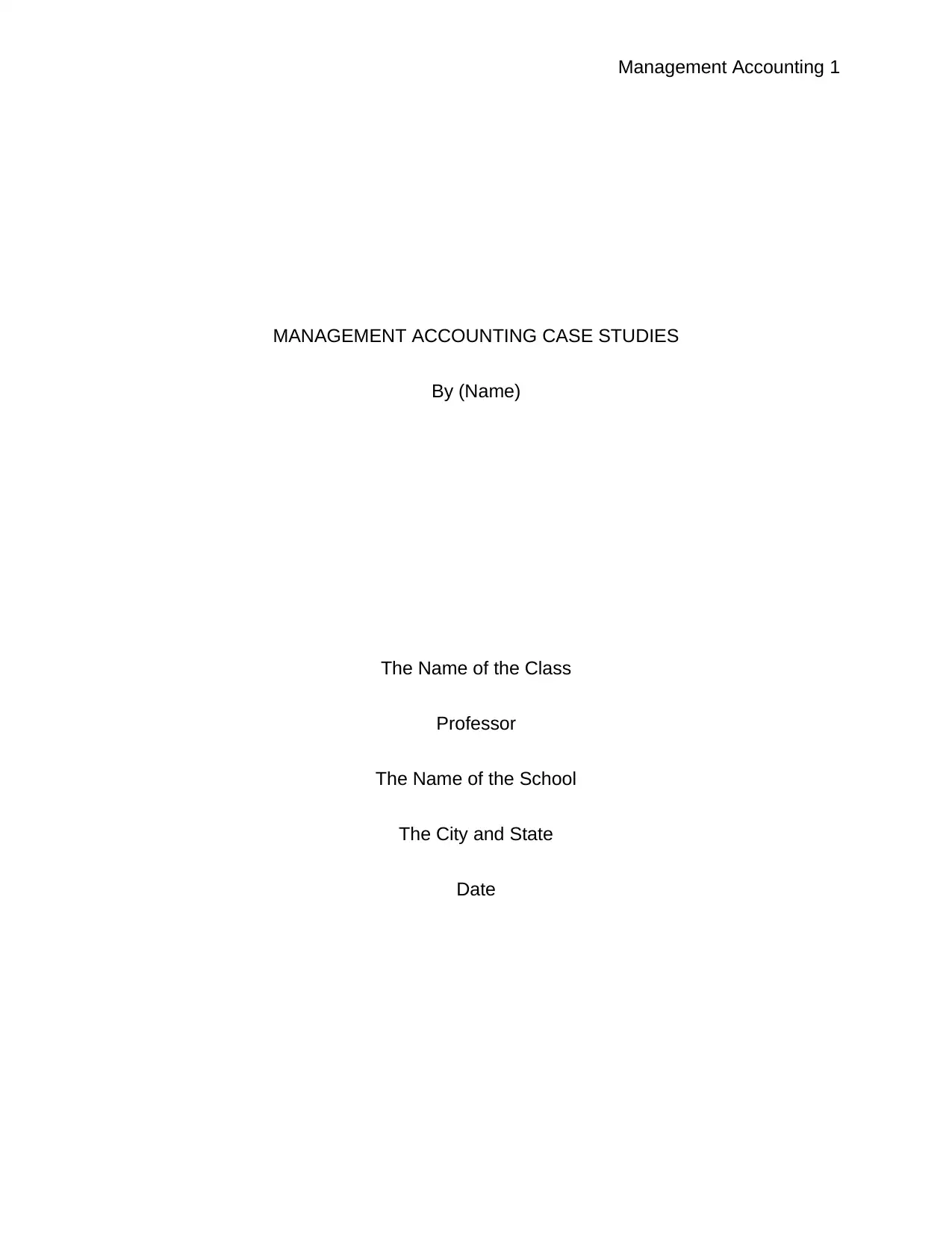
Management Accounting 1
MANAGEMENT ACCOUNTING CASE STUDIES
By (Name)
The Name of the Class
Professor
The Name of the School
The City and State
Date
MANAGEMENT ACCOUNTING CASE STUDIES
By (Name)
The Name of the Class
Professor
The Name of the School
The City and State
Date
Paraphrase This Document
Need a fresh take? Get an instant paraphrase of this document with our AI Paraphraser
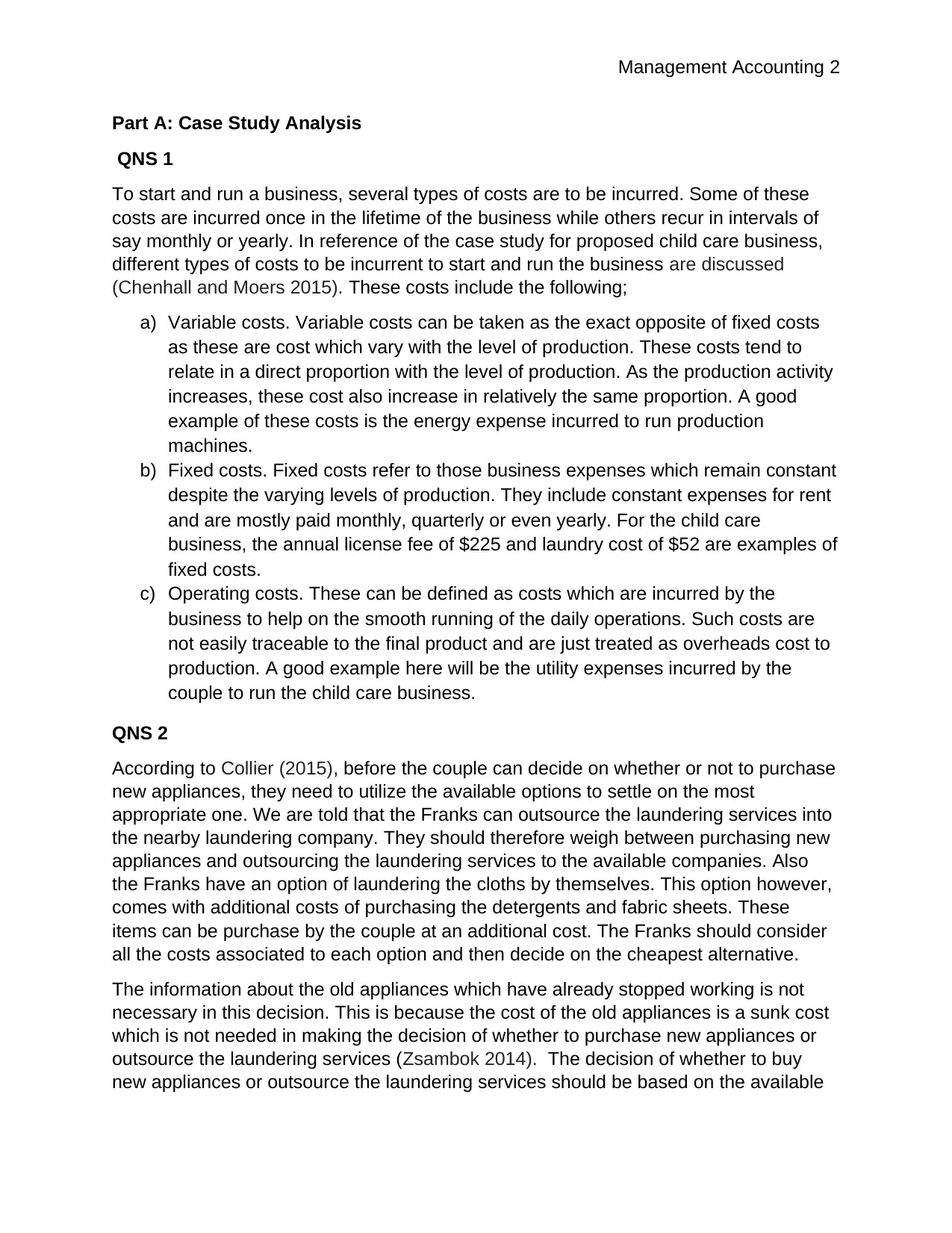
Management Accounting 2
Part A: Case Study Analysis
QNS 1
To start and run a business, several types of costs are to be incurred. Some of these
costs are incurred once in the lifetime of the business while others recur in intervals of
say monthly or yearly. In reference of the case study for proposed child care business,
different types of costs to be incurrent to start and run the business are discussed
(Chenhall and Moers 2015). These costs include the following;
a) Variable costs. Variable costs can be taken as the exact opposite of fixed costs
as these are cost which vary with the level of production. These costs tend to
relate in a direct proportion with the level of production. As the production activity
increases, these cost also increase in relatively the same proportion. A good
example of these costs is the energy expense incurred to run production
machines.
b) Fixed costs. Fixed costs refer to those business expenses which remain constant
despite the varying levels of production. They include constant expenses for rent
and are mostly paid monthly, quarterly or even yearly. For the child care
business, the annual license fee of $225 and laundry cost of $52 are examples of
fixed costs.
c) Operating costs. These can be defined as costs which are incurred by the
business to help on the smooth running of the daily operations. Such costs are
not easily traceable to the final product and are just treated as overheads cost to
production. A good example here will be the utility expenses incurred by the
couple to run the child care business.
QNS 2
According to Collier (2015), before the couple can decide on whether or not to purchase
new appliances, they need to utilize the available options to settle on the most
appropriate one. We are told that the Franks can outsource the laundering services into
the nearby laundering company. They should therefore weigh between purchasing new
appliances and outsourcing the laundering services to the available companies. Also
the Franks have an option of laundering the cloths by themselves. This option however,
comes with additional costs of purchasing the detergents and fabric sheets. These
items can be purchase by the couple at an additional cost. The Franks should consider
all the costs associated to each option and then decide on the cheapest alternative.
The information about the old appliances which have already stopped working is not
necessary in this decision. This is because the cost of the old appliances is a sunk cost
which is not needed in making the decision of whether to purchase new appliances or
outsource the laundering services (Zsambok 2014). The decision of whether to buy
new appliances or outsource the laundering services should be based on the available
Part A: Case Study Analysis
QNS 1
To start and run a business, several types of costs are to be incurred. Some of these
costs are incurred once in the lifetime of the business while others recur in intervals of
say monthly or yearly. In reference of the case study for proposed child care business,
different types of costs to be incurrent to start and run the business are discussed
(Chenhall and Moers 2015). These costs include the following;
a) Variable costs. Variable costs can be taken as the exact opposite of fixed costs
as these are cost which vary with the level of production. These costs tend to
relate in a direct proportion with the level of production. As the production activity
increases, these cost also increase in relatively the same proportion. A good
example of these costs is the energy expense incurred to run production
machines.
b) Fixed costs. Fixed costs refer to those business expenses which remain constant
despite the varying levels of production. They include constant expenses for rent
and are mostly paid monthly, quarterly or even yearly. For the child care
business, the annual license fee of $225 and laundry cost of $52 are examples of
fixed costs.
c) Operating costs. These can be defined as costs which are incurred by the
business to help on the smooth running of the daily operations. Such costs are
not easily traceable to the final product and are just treated as overheads cost to
production. A good example here will be the utility expenses incurred by the
couple to run the child care business.
QNS 2
According to Collier (2015), before the couple can decide on whether or not to purchase
new appliances, they need to utilize the available options to settle on the most
appropriate one. We are told that the Franks can outsource the laundering services into
the nearby laundering company. They should therefore weigh between purchasing new
appliances and outsourcing the laundering services to the available companies. Also
the Franks have an option of laundering the cloths by themselves. This option however,
comes with additional costs of purchasing the detergents and fabric sheets. These
items can be purchase by the couple at an additional cost. The Franks should consider
all the costs associated to each option and then decide on the cheapest alternative.
The information about the old appliances which have already stopped working is not
necessary in this decision. This is because the cost of the old appliances is a sunk cost
which is not needed in making the decision of whether to purchase new appliances or
outsource the laundering services (Zsambok 2014). The decision of whether to buy
new appliances or outsource the laundering services should be based on the available
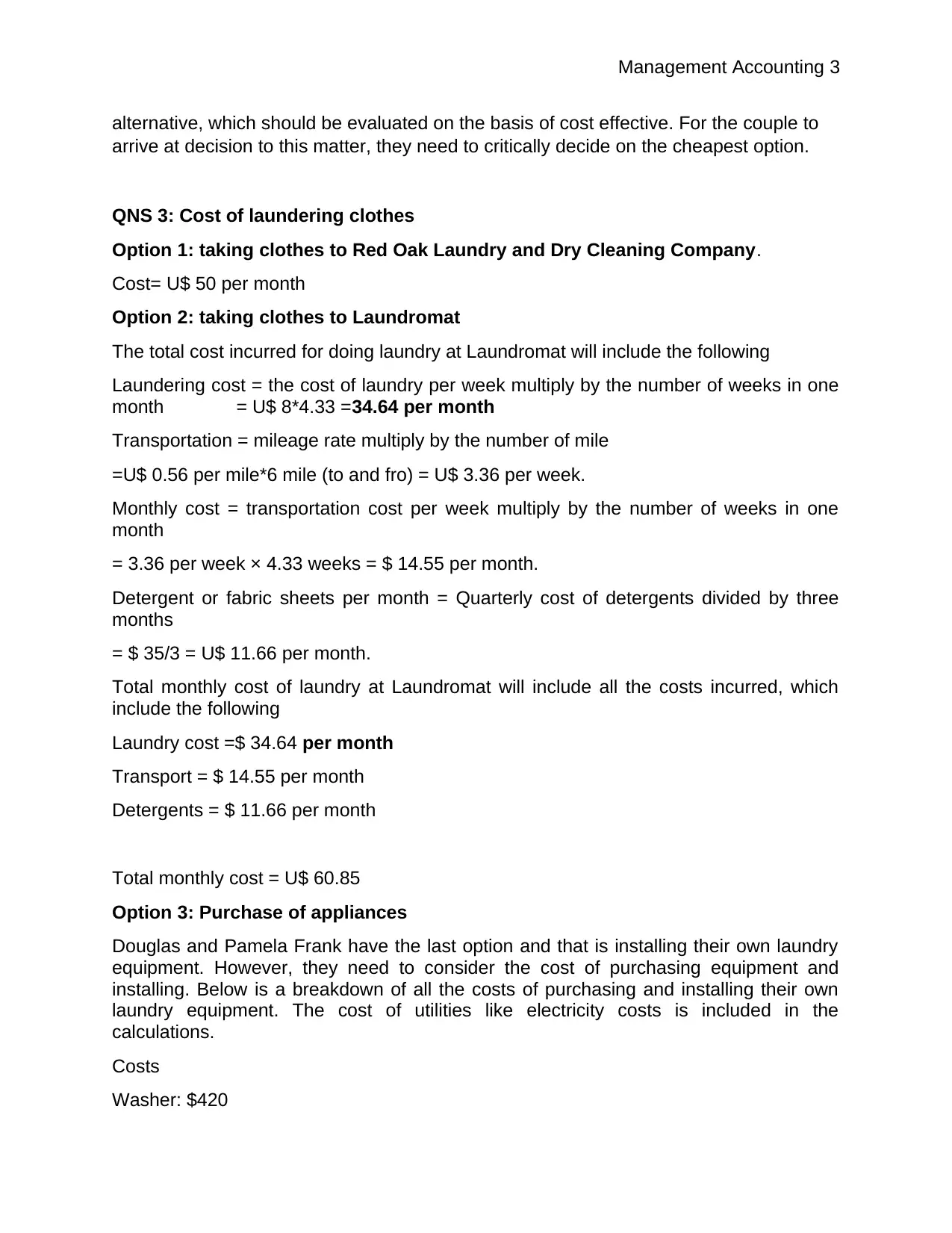
Management Accounting 3
alternative, which should be evaluated on the basis of cost effective. For the couple to
arrive at decision to this matter, they need to critically decide on the cheapest option.
QNS 3: Cost of laundering clothes
Option 1: taking clothes to Red Oak Laundry and Dry Cleaning Company.
Cost= U$ 50 per month
Option 2: taking clothes to Laundromat
The total cost incurred for doing laundry at Laundromat will include the following
Laundering cost = the cost of laundry per week multiply by the number of weeks in one
month = U$ 8*4.33 =34.64 per month
Transportation = mileage rate multiply by the number of mile
=U$ 0.56 per mile*6 mile (to and fro) = U$ 3.36 per week.
Monthly cost = transportation cost per week multiply by the number of weeks in one
month
= 3.36 per week × 4.33 weeks = $ 14.55 per month.
Detergent or fabric sheets per month = Quarterly cost of detergents divided by three
months
= $ 35/3 = U$ 11.66 per month.
Total monthly cost of laundry at Laundromat will include all the costs incurred, which
include the following
Laundry cost =$ 34.64 per month
Transport = $ 14.55 per month
Detergents = $ 11.66 per month
Total monthly cost = U$ 60.85
Option 3: Purchase of appliances
Douglas and Pamela Frank have the last option and that is installing their own laundry
equipment. However, they need to consider the cost of purchasing equipment and
installing. Below is a breakdown of all the costs of purchasing and installing their own
laundry equipment. The cost of utilities like electricity costs is included in the
calculations.
Costs
Washer: $420
alternative, which should be evaluated on the basis of cost effective. For the couple to
arrive at decision to this matter, they need to critically decide on the cheapest option.
QNS 3: Cost of laundering clothes
Option 1: taking clothes to Red Oak Laundry and Dry Cleaning Company.
Cost= U$ 50 per month
Option 2: taking clothes to Laundromat
The total cost incurred for doing laundry at Laundromat will include the following
Laundering cost = the cost of laundry per week multiply by the number of weeks in one
month = U$ 8*4.33 =34.64 per month
Transportation = mileage rate multiply by the number of mile
=U$ 0.56 per mile*6 mile (to and fro) = U$ 3.36 per week.
Monthly cost = transportation cost per week multiply by the number of weeks in one
month
= 3.36 per week × 4.33 weeks = $ 14.55 per month.
Detergent or fabric sheets per month = Quarterly cost of detergents divided by three
months
= $ 35/3 = U$ 11.66 per month.
Total monthly cost of laundry at Laundromat will include all the costs incurred, which
include the following
Laundry cost =$ 34.64 per month
Transport = $ 14.55 per month
Detergents = $ 11.66 per month
Total monthly cost = U$ 60.85
Option 3: Purchase of appliances
Douglas and Pamela Frank have the last option and that is installing their own laundry
equipment. However, they need to consider the cost of purchasing equipment and
installing. Below is a breakdown of all the costs of purchasing and installing their own
laundry equipment. The cost of utilities like electricity costs is included in the
calculations.
Costs
Washer: $420
⊘ This is a preview!⊘
Do you want full access?
Subscribe today to unlock all pages.

Trusted by 1+ million students worldwide
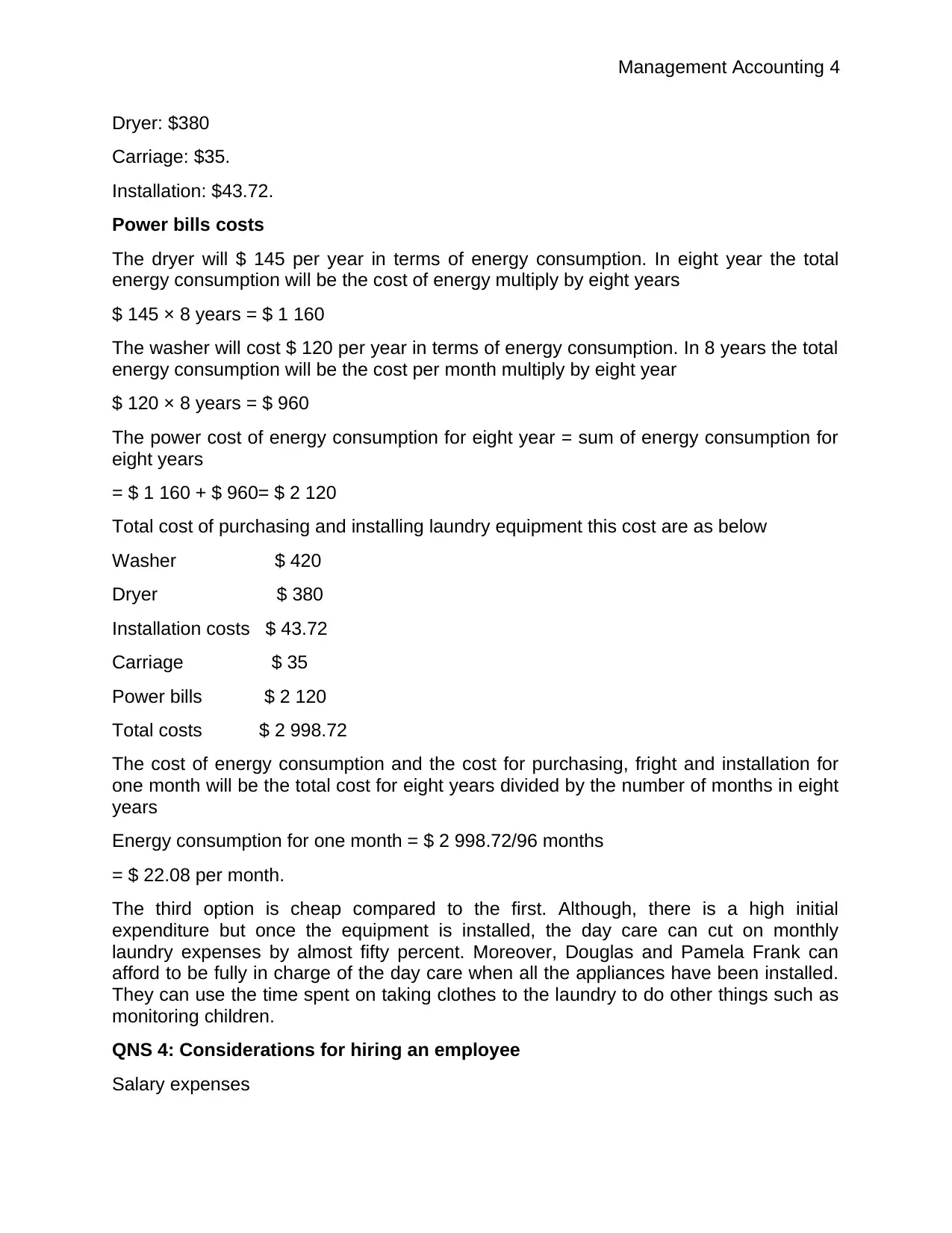
Management Accounting 4
Dryer: $380
Carriage: $35.
Installation: $43.72.
Power bills costs
The dryer will $ 145 per year in terms of energy consumption. In eight year the total
energy consumption will be the cost of energy multiply by eight years
$ 145 × 8 years = $ 1 160
The washer will cost $ 120 per year in terms of energy consumption. In 8 years the total
energy consumption will be the cost per month multiply by eight year
$ 120 × 8 years = $ 960
The power cost of energy consumption for eight year = sum of energy consumption for
eight years
= $ 1 160 + $ 960= $ 2 120
Total cost of purchasing and installing laundry equipment this cost are as below
Washer $ 420
Dryer $ 380
Installation costs $ 43.72
Carriage $ 35
Power bills $ 2 120
Total costs $ 2 998.72
The cost of energy consumption and the cost for purchasing, fright and installation for
one month will be the total cost for eight years divided by the number of months in eight
years
Energy consumption for one month = $ 2 998.72/96 months
= $ 22.08 per month.
The third option is cheap compared to the first. Although, there is a high initial
expenditure but once the equipment is installed, the day care can cut on monthly
laundry expenses by almost fifty percent. Moreover, Douglas and Pamela Frank can
afford to be fully in charge of the day care when all the appliances have been installed.
They can use the time spent on taking clothes to the laundry to do other things such as
monitoring children.
QNS 4: Considerations for hiring an employee
Salary expenses
Dryer: $380
Carriage: $35.
Installation: $43.72.
Power bills costs
The dryer will $ 145 per year in terms of energy consumption. In eight year the total
energy consumption will be the cost of energy multiply by eight years
$ 145 × 8 years = $ 1 160
The washer will cost $ 120 per year in terms of energy consumption. In 8 years the total
energy consumption will be the cost per month multiply by eight year
$ 120 × 8 years = $ 960
The power cost of energy consumption for eight year = sum of energy consumption for
eight years
= $ 1 160 + $ 960= $ 2 120
Total cost of purchasing and installing laundry equipment this cost are as below
Washer $ 420
Dryer $ 380
Installation costs $ 43.72
Carriage $ 35
Power bills $ 2 120
Total costs $ 2 998.72
The cost of energy consumption and the cost for purchasing, fright and installation for
one month will be the total cost for eight years divided by the number of months in eight
years
Energy consumption for one month = $ 2 998.72/96 months
= $ 22.08 per month.
The third option is cheap compared to the first. Although, there is a high initial
expenditure but once the equipment is installed, the day care can cut on monthly
laundry expenses by almost fifty percent. Moreover, Douglas and Pamela Frank can
afford to be fully in charge of the day care when all the appliances have been installed.
They can use the time spent on taking clothes to the laundry to do other things such as
monitoring children.
QNS 4: Considerations for hiring an employee
Salary expenses
Paraphrase This Document
Need a fresh take? Get an instant paraphrase of this document with our AI Paraphraser

Management Accounting 5
Weekly wage for the employee = number of hours worked multiply by the rate per hour
= U$ 9*40 hours = U$ 360 per week
Monthly wage for the employee = weekly wage multiply by the number of weeks in one
month
= U$ 360 per week × 4.33 weeks (assuming that there is no overtime)
= Monthly salary expenses = 360*4.33 = 1 558.80
Other expenses include
Maintenance cost per month = Maintenance cost per year divided by the number of
months in a year
$ 225/ 12 = $ 18.75
Insurance per month = insurance cost per year divided by 12, (the number of months in
a year)
$ 3 840/12 = $ 320
Meals and Snack per day per child = $3.2
The cost for snack for 9 children per day = 9 × 3.32 × 5 = $ 149.40 which translates to
$646.90
Daily total of $ 149.40 × 4.33 weeks = $ 646.90
Total Expenses is the sum of all the uncured costs per month these include
Salary for employee = $ 1 558.80
Maintenance cost = $ 18.75
Monthly Insurance = $ 320
Monthly cost of snack= $ 646.90
Total monthly expenses = $ 2 544.45
Revenue generated
With one employee the day care can allow three more children in the day. This makes
the total number of children in the day care to be nine.
Monthly income = the number of children multiply by the day fee per month
800*9 = $ 7 200
To determine the net profit, all the monthly expenses are subtracted from the revenue
generated per month.
Net profit = $ 7 200 - $ 2 544.45
$ 4 655.55
Weekly wage for the employee = number of hours worked multiply by the rate per hour
= U$ 9*40 hours = U$ 360 per week
Monthly wage for the employee = weekly wage multiply by the number of weeks in one
month
= U$ 360 per week × 4.33 weeks (assuming that there is no overtime)
= Monthly salary expenses = 360*4.33 = 1 558.80
Other expenses include
Maintenance cost per month = Maintenance cost per year divided by the number of
months in a year
$ 225/ 12 = $ 18.75
Insurance per month = insurance cost per year divided by 12, (the number of months in
a year)
$ 3 840/12 = $ 320
Meals and Snack per day per child = $3.2
The cost for snack for 9 children per day = 9 × 3.32 × 5 = $ 149.40 which translates to
$646.90
Daily total of $ 149.40 × 4.33 weeks = $ 646.90
Total Expenses is the sum of all the uncured costs per month these include
Salary for employee = $ 1 558.80
Maintenance cost = $ 18.75
Monthly Insurance = $ 320
Monthly cost of snack= $ 646.90
Total monthly expenses = $ 2 544.45
Revenue generated
With one employee the day care can allow three more children in the day. This makes
the total number of children in the day care to be nine.
Monthly income = the number of children multiply by the day fee per month
800*9 = $ 7 200
To determine the net profit, all the monthly expenses are subtracted from the revenue
generated per month.
Net profit = $ 7 200 - $ 2 544.45
$ 4 655.55
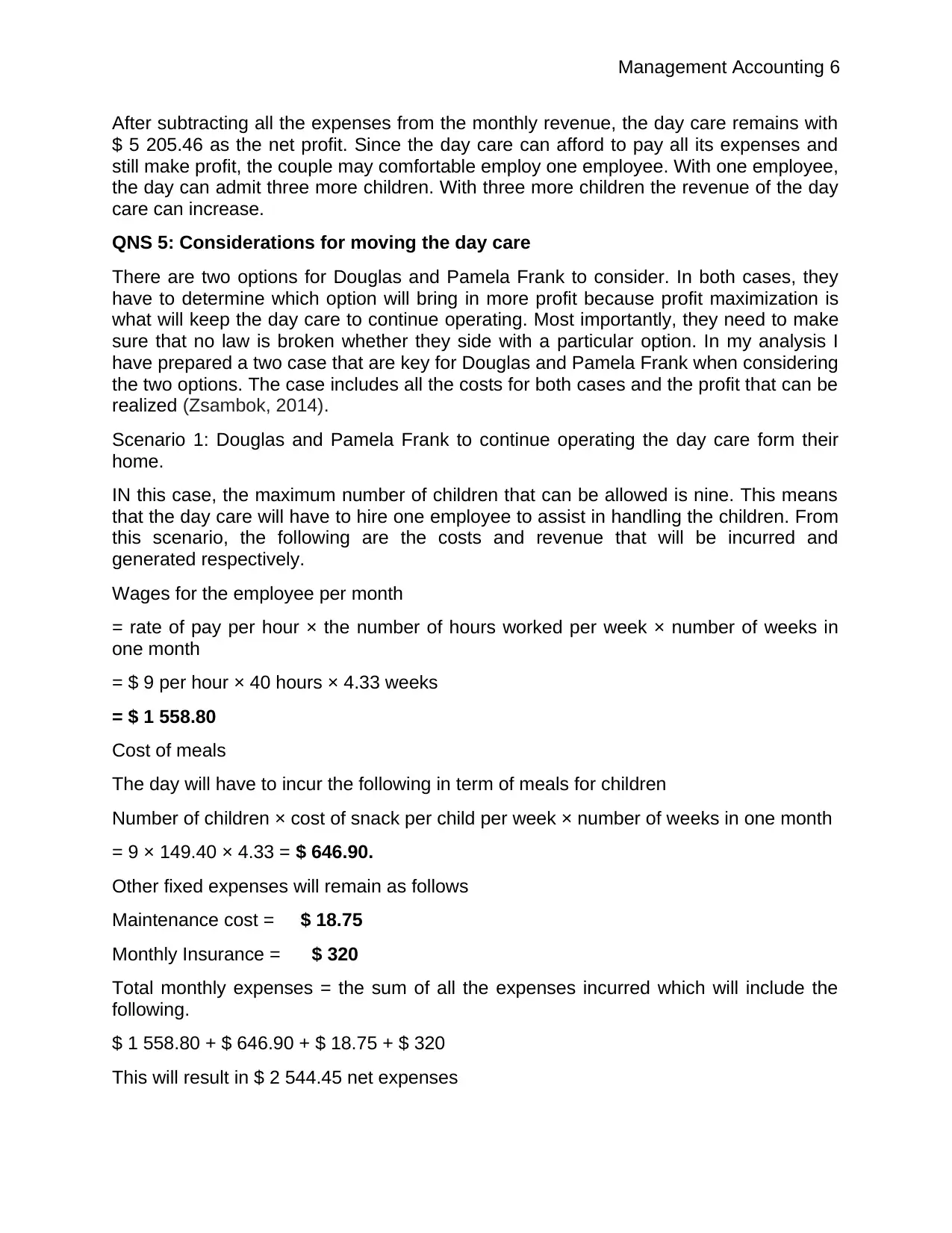
Management Accounting 6
After subtracting all the expenses from the monthly revenue, the day care remains with
$ 5 205.46 as the net profit. Since the day care can afford to pay all its expenses and
still make profit, the couple may comfortable employ one employee. With one employee,
the day can admit three more children. With three more children the revenue of the day
care can increase.
QNS 5: Considerations for moving the day care
There are two options for Douglas and Pamela Frank to consider. In both cases, they
have to determine which option will bring in more profit because profit maximization is
what will keep the day care to continue operating. Most importantly, they need to make
sure that no law is broken whether they side with a particular option. In my analysis I
have prepared a two case that are key for Douglas and Pamela Frank when considering
the two options. The case includes all the costs for both cases and the profit that can be
realized (Zsambok, 2014).
Scenario 1: Douglas and Pamela Frank to continue operating the day care form their
home.
IN this case, the maximum number of children that can be allowed is nine. This means
that the day care will have to hire one employee to assist in handling the children. From
this scenario, the following are the costs and revenue that will be incurred and
generated respectively.
Wages for the employee per month
= rate of pay per hour × the number of hours worked per week × number of weeks in
one month
= $ 9 per hour × 40 hours × 4.33 weeks
= $ 1 558.80
Cost of meals
The day will have to incur the following in term of meals for children
Number of children × cost of snack per child per week × number of weeks in one month
= 9 × 149.40 × 4.33 = $ 646.90.
Other fixed expenses will remain as follows
Maintenance cost = $ 18.75
Monthly Insurance = $ 320
Total monthly expenses = the sum of all the expenses incurred which will include the
following.
$ 1 558.80 + $ 646.90 + $ 18.75 + $ 320
This will result in $ 2 544.45 net expenses
After subtracting all the expenses from the monthly revenue, the day care remains with
$ 5 205.46 as the net profit. Since the day care can afford to pay all its expenses and
still make profit, the couple may comfortable employ one employee. With one employee,
the day can admit three more children. With three more children the revenue of the day
care can increase.
QNS 5: Considerations for moving the day care
There are two options for Douglas and Pamela Frank to consider. In both cases, they
have to determine which option will bring in more profit because profit maximization is
what will keep the day care to continue operating. Most importantly, they need to make
sure that no law is broken whether they side with a particular option. In my analysis I
have prepared a two case that are key for Douglas and Pamela Frank when considering
the two options. The case includes all the costs for both cases and the profit that can be
realized (Zsambok, 2014).
Scenario 1: Douglas and Pamela Frank to continue operating the day care form their
home.
IN this case, the maximum number of children that can be allowed is nine. This means
that the day care will have to hire one employee to assist in handling the children. From
this scenario, the following are the costs and revenue that will be incurred and
generated respectively.
Wages for the employee per month
= rate of pay per hour × the number of hours worked per week × number of weeks in
one month
= $ 9 per hour × 40 hours × 4.33 weeks
= $ 1 558.80
Cost of meals
The day will have to incur the following in term of meals for children
Number of children × cost of snack per child per week × number of weeks in one month
= 9 × 149.40 × 4.33 = $ 646.90.
Other fixed expenses will remain as follows
Maintenance cost = $ 18.75
Monthly Insurance = $ 320
Total monthly expenses = the sum of all the expenses incurred which will include the
following.
$ 1 558.80 + $ 646.90 + $ 18.75 + $ 320
This will result in $ 2 544.45 net expenses
⊘ This is a preview!⊘
Do you want full access?
Subscribe today to unlock all pages.

Trusted by 1+ million students worldwide
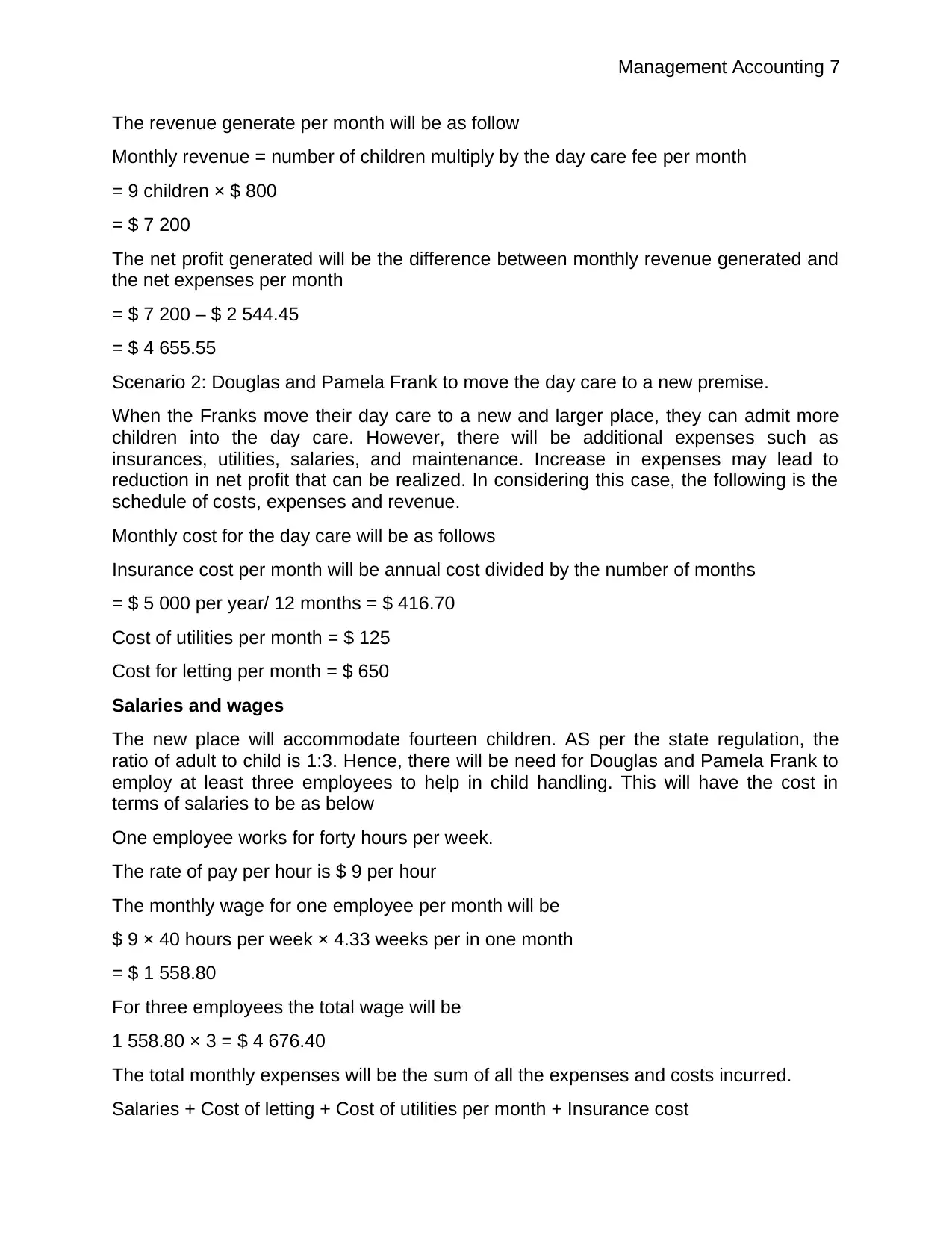
Management Accounting 7
The revenue generate per month will be as follow
Monthly revenue = number of children multiply by the day care fee per month
= 9 children × $ 800
= $ 7 200
The net profit generated will be the difference between monthly revenue generated and
the net expenses per month
= $ 7 200 – $ 2 544.45
= $ 4 655.55
Scenario 2: Douglas and Pamela Frank to move the day care to a new premise.
When the Franks move their day care to a new and larger place, they can admit more
children into the day care. However, there will be additional expenses such as
insurances, utilities, salaries, and maintenance. Increase in expenses may lead to
reduction in net profit that can be realized. In considering this case, the following is the
schedule of costs, expenses and revenue.
Monthly cost for the day care will be as follows
Insurance cost per month will be annual cost divided by the number of months
= $ 5 000 per year/ 12 months = $ 416.70
Cost of utilities per month = $ 125
Cost for letting per month = $ 650
Salaries and wages
The new place will accommodate fourteen children. AS per the state regulation, the
ratio of adult to child is 1:3. Hence, there will be need for Douglas and Pamela Frank to
employ at least three employees to help in child handling. This will have the cost in
terms of salaries to be as below
One employee works for forty hours per week.
The rate of pay per hour is $ 9 per hour
The monthly wage for one employee per month will be
$ 9 × 40 hours per week × 4.33 weeks per in one month
= $ 1 558.80
For three employees the total wage will be
1 558.80 × 3 = $ 4 676.40
The total monthly expenses will be the sum of all the expenses and costs incurred.
Salaries + Cost of letting + Cost of utilities per month + Insurance cost
The revenue generate per month will be as follow
Monthly revenue = number of children multiply by the day care fee per month
= 9 children × $ 800
= $ 7 200
The net profit generated will be the difference between monthly revenue generated and
the net expenses per month
= $ 7 200 – $ 2 544.45
= $ 4 655.55
Scenario 2: Douglas and Pamela Frank to move the day care to a new premise.
When the Franks move their day care to a new and larger place, they can admit more
children into the day care. However, there will be additional expenses such as
insurances, utilities, salaries, and maintenance. Increase in expenses may lead to
reduction in net profit that can be realized. In considering this case, the following is the
schedule of costs, expenses and revenue.
Monthly cost for the day care will be as follows
Insurance cost per month will be annual cost divided by the number of months
= $ 5 000 per year/ 12 months = $ 416.70
Cost of utilities per month = $ 125
Cost for letting per month = $ 650
Salaries and wages
The new place will accommodate fourteen children. AS per the state regulation, the
ratio of adult to child is 1:3. Hence, there will be need for Douglas and Pamela Frank to
employ at least three employees to help in child handling. This will have the cost in
terms of salaries to be as below
One employee works for forty hours per week.
The rate of pay per hour is $ 9 per hour
The monthly wage for one employee per month will be
$ 9 × 40 hours per week × 4.33 weeks per in one month
= $ 1 558.80
For three employees the total wage will be
1 558.80 × 3 = $ 4 676.40
The total monthly expenses will be the sum of all the expenses and costs incurred.
Salaries + Cost of letting + Cost of utilities per month + Insurance cost
Paraphrase This Document
Need a fresh take? Get an instant paraphrase of this document with our AI Paraphraser
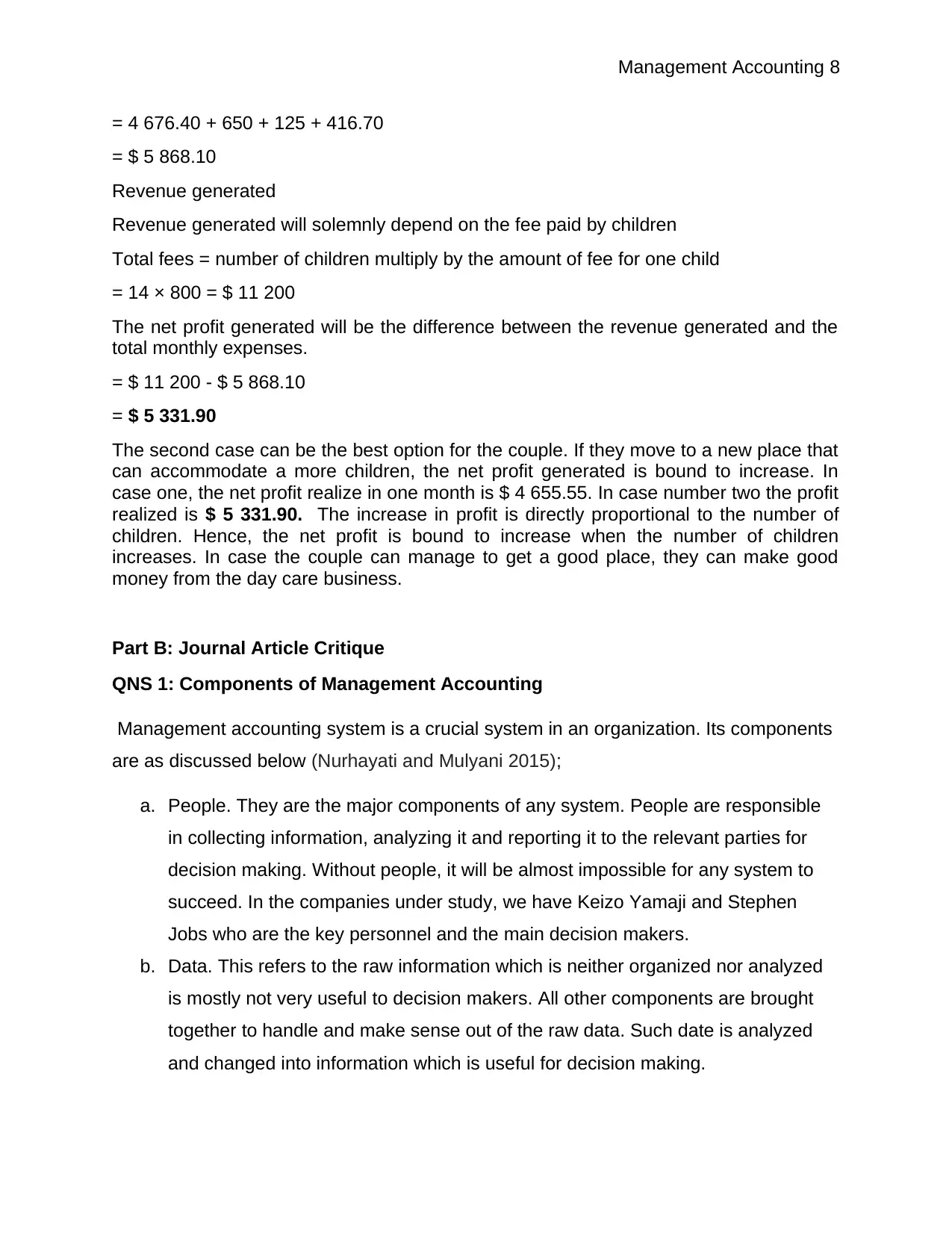
Management Accounting 8
= 4 676.40 + 650 + 125 + 416.70
= $ 5 868.10
Revenue generated
Revenue generated will solemnly depend on the fee paid by children
Total fees = number of children multiply by the amount of fee for one child
= 14 × 800 = $ 11 200
The net profit generated will be the difference between the revenue generated and the
total monthly expenses.
= $ 11 200 - $ 5 868.10
= $ 5 331.90
The second case can be the best option for the couple. If they move to a new place that
can accommodate a more children, the net profit generated is bound to increase. In
case one, the net profit realize in one month is $ 4 655.55. In case number two the profit
realized is $ 5 331.90. The increase in profit is directly proportional to the number of
children. Hence, the net profit is bound to increase when the number of children
increases. In case the couple can manage to get a good place, they can make good
money from the day care business.
Part B: Journal Article Critique
QNS 1: Components of Management Accounting
Management accounting system is a crucial system in an organization. Its components
are as discussed below (Nurhayati and Mulyani 2015);
a. People. They are the major components of any system. People are responsible
in collecting information, analyzing it and reporting it to the relevant parties for
decision making. Without people, it will be almost impossible for any system to
succeed. In the companies under study, we have Keizo Yamaji and Stephen
Jobs who are the key personnel and the main decision makers.
b. Data. This refers to the raw information which is neither organized nor analyzed
is mostly not very useful to decision makers. All other components are brought
together to handle and make sense out of the raw data. Such date is analyzed
and changed into information which is useful for decision making.
= 4 676.40 + 650 + 125 + 416.70
= $ 5 868.10
Revenue generated
Revenue generated will solemnly depend on the fee paid by children
Total fees = number of children multiply by the amount of fee for one child
= 14 × 800 = $ 11 200
The net profit generated will be the difference between the revenue generated and the
total monthly expenses.
= $ 11 200 - $ 5 868.10
= $ 5 331.90
The second case can be the best option for the couple. If they move to a new place that
can accommodate a more children, the net profit generated is bound to increase. In
case one, the net profit realize in one month is $ 4 655.55. In case number two the profit
realized is $ 5 331.90. The increase in profit is directly proportional to the number of
children. Hence, the net profit is bound to increase when the number of children
increases. In case the couple can manage to get a good place, they can make good
money from the day care business.
Part B: Journal Article Critique
QNS 1: Components of Management Accounting
Management accounting system is a crucial system in an organization. Its components
are as discussed below (Nurhayati and Mulyani 2015);
a. People. They are the major components of any system. People are responsible
in collecting information, analyzing it and reporting it to the relevant parties for
decision making. Without people, it will be almost impossible for any system to
succeed. In the companies under study, we have Keizo Yamaji and Stephen
Jobs who are the key personnel and the main decision makers.
b. Data. This refers to the raw information which is neither organized nor analyzed
is mostly not very useful to decision makers. All other components are brought
together to handle and make sense out of the raw data. Such date is analyzed
and changed into information which is useful for decision making.
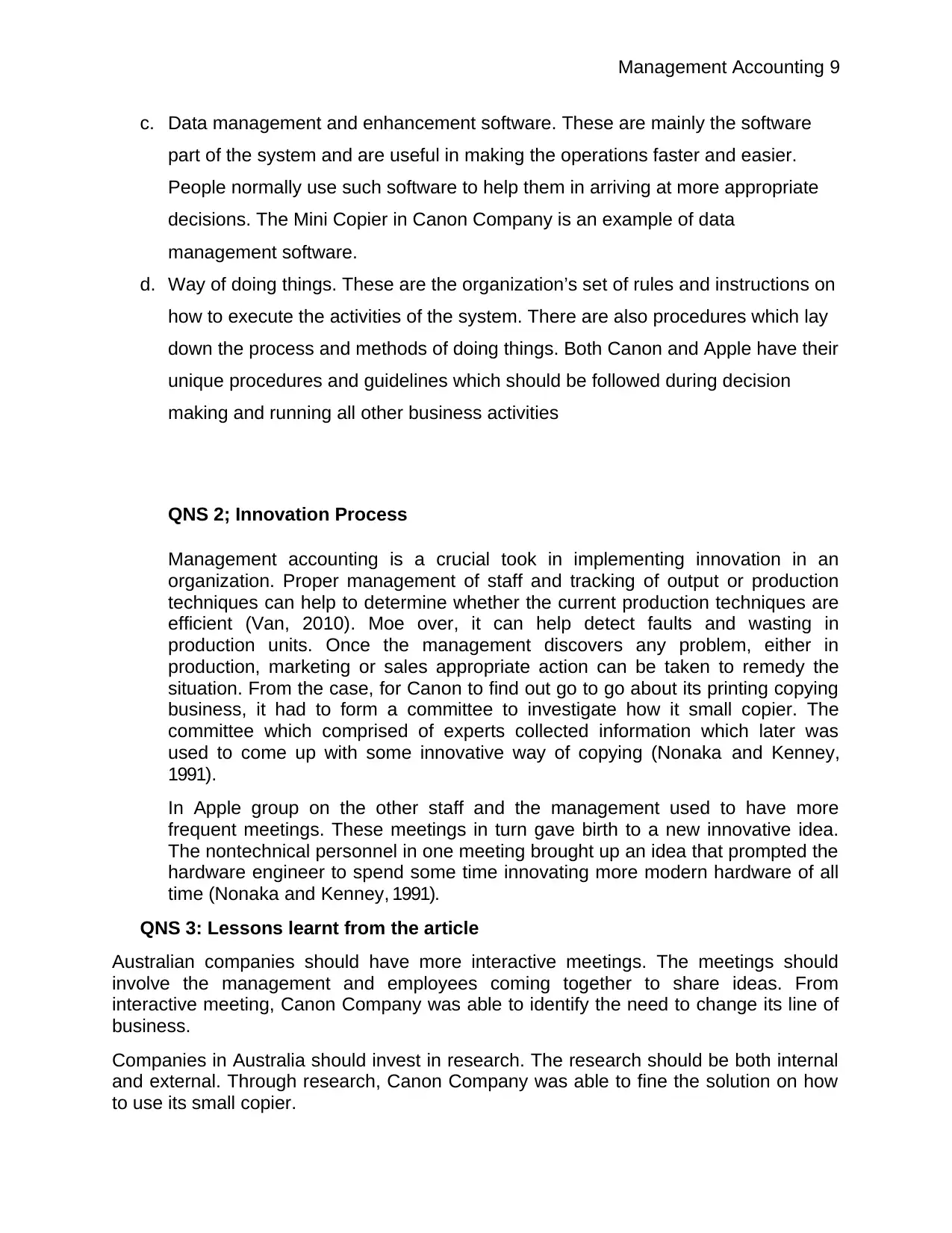
Management Accounting 9
c. Data management and enhancement software. These are mainly the software
part of the system and are useful in making the operations faster and easier.
People normally use such software to help them in arriving at more appropriate
decisions. The Mini Copier in Canon Company is an example of data
management software.
d. Way of doing things. These are the organization’s set of rules and instructions on
how to execute the activities of the system. There are also procedures which lay
down the process and methods of doing things. Both Canon and Apple have their
unique procedures and guidelines which should be followed during decision
making and running all other business activities
QNS 2; Innovation Process
Management accounting is a crucial took in implementing innovation in an
organization. Proper management of staff and tracking of output or production
techniques can help to determine whether the current production techniques are
efficient (Van, 2010). Moe over, it can help detect faults and wasting in
production units. Once the management discovers any problem, either in
production, marketing or sales appropriate action can be taken to remedy the
situation. From the case, for Canon to find out go to go about its printing copying
business, it had to form a committee to investigate how it small copier. The
committee which comprised of experts collected information which later was
used to come up with some innovative way of copying (Nonaka and Kenney,
1991).
In Apple group on the other staff and the management used to have more
frequent meetings. These meetings in turn gave birth to a new innovative idea.
The nontechnical personnel in one meeting brought up an idea that prompted the
hardware engineer to spend some time innovating more modern hardware of all
time (Nonaka and Kenney, 1991).
QNS 3: Lessons learnt from the article
Australian companies should have more interactive meetings. The meetings should
involve the management and employees coming together to share ideas. From
interactive meeting, Canon Company was able to identify the need to change its line of
business.
Companies in Australia should invest in research. The research should be both internal
and external. Through research, Canon Company was able to fine the solution on how
to use its small copier.
c. Data management and enhancement software. These are mainly the software
part of the system and are useful in making the operations faster and easier.
People normally use such software to help them in arriving at more appropriate
decisions. The Mini Copier in Canon Company is an example of data
management software.
d. Way of doing things. These are the organization’s set of rules and instructions on
how to execute the activities of the system. There are also procedures which lay
down the process and methods of doing things. Both Canon and Apple have their
unique procedures and guidelines which should be followed during decision
making and running all other business activities
QNS 2; Innovation Process
Management accounting is a crucial took in implementing innovation in an
organization. Proper management of staff and tracking of output or production
techniques can help to determine whether the current production techniques are
efficient (Van, 2010). Moe over, it can help detect faults and wasting in
production units. Once the management discovers any problem, either in
production, marketing or sales appropriate action can be taken to remedy the
situation. From the case, for Canon to find out go to go about its printing copying
business, it had to form a committee to investigate how it small copier. The
committee which comprised of experts collected information which later was
used to come up with some innovative way of copying (Nonaka and Kenney,
1991).
In Apple group on the other staff and the management used to have more
frequent meetings. These meetings in turn gave birth to a new innovative idea.
The nontechnical personnel in one meeting brought up an idea that prompted the
hardware engineer to spend some time innovating more modern hardware of all
time (Nonaka and Kenney, 1991).
QNS 3: Lessons learnt from the article
Australian companies should have more interactive meetings. The meetings should
involve the management and employees coming together to share ideas. From
interactive meeting, Canon Company was able to identify the need to change its line of
business.
Companies in Australia should invest in research. The research should be both internal
and external. Through research, Canon Company was able to fine the solution on how
to use its small copier.
⊘ This is a preview!⊘
Do you want full access?
Subscribe today to unlock all pages.

Trusted by 1+ million students worldwide
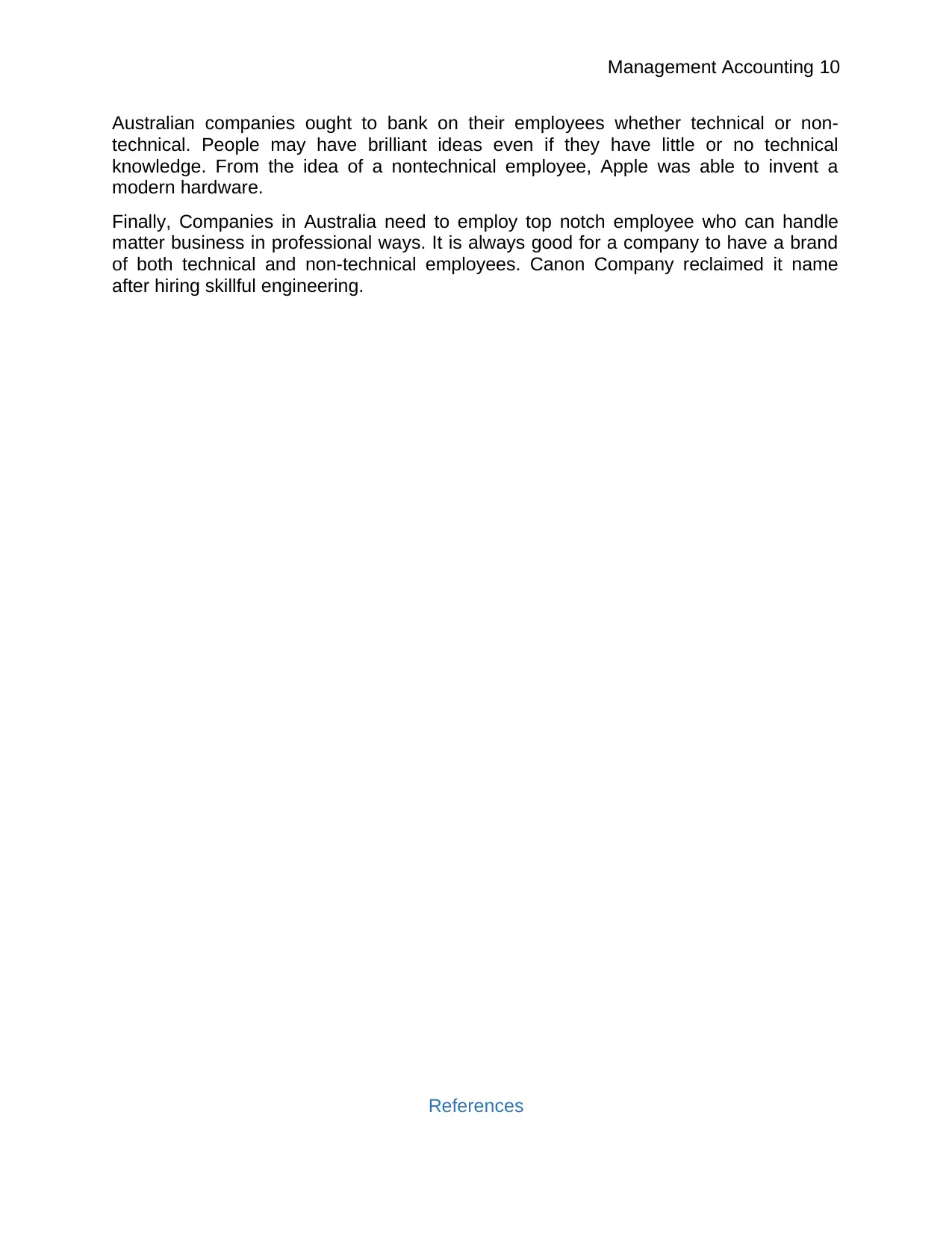
Management Accounting 10
Australian companies ought to bank on their employees whether technical or non-
technical. People may have brilliant ideas even if they have little or no technical
knowledge. From the idea of a nontechnical employee, Apple was able to invent a
modern hardware.
Finally, Companies in Australia need to employ top notch employee who can handle
matter business in professional ways. It is always good for a company to have a brand
of both technical and non-technical employees. Canon Company reclaimed it name
after hiring skillful engineering.
References
Australian companies ought to bank on their employees whether technical or non-
technical. People may have brilliant ideas even if they have little or no technical
knowledge. From the idea of a nontechnical employee, Apple was able to invent a
modern hardware.
Finally, Companies in Australia need to employ top notch employee who can handle
matter business in professional ways. It is always good for a company to have a brand
of both technical and non-technical employees. Canon Company reclaimed it name
after hiring skillful engineering.
References
Paraphrase This Document
Need a fresh take? Get an instant paraphrase of this document with our AI Paraphraser
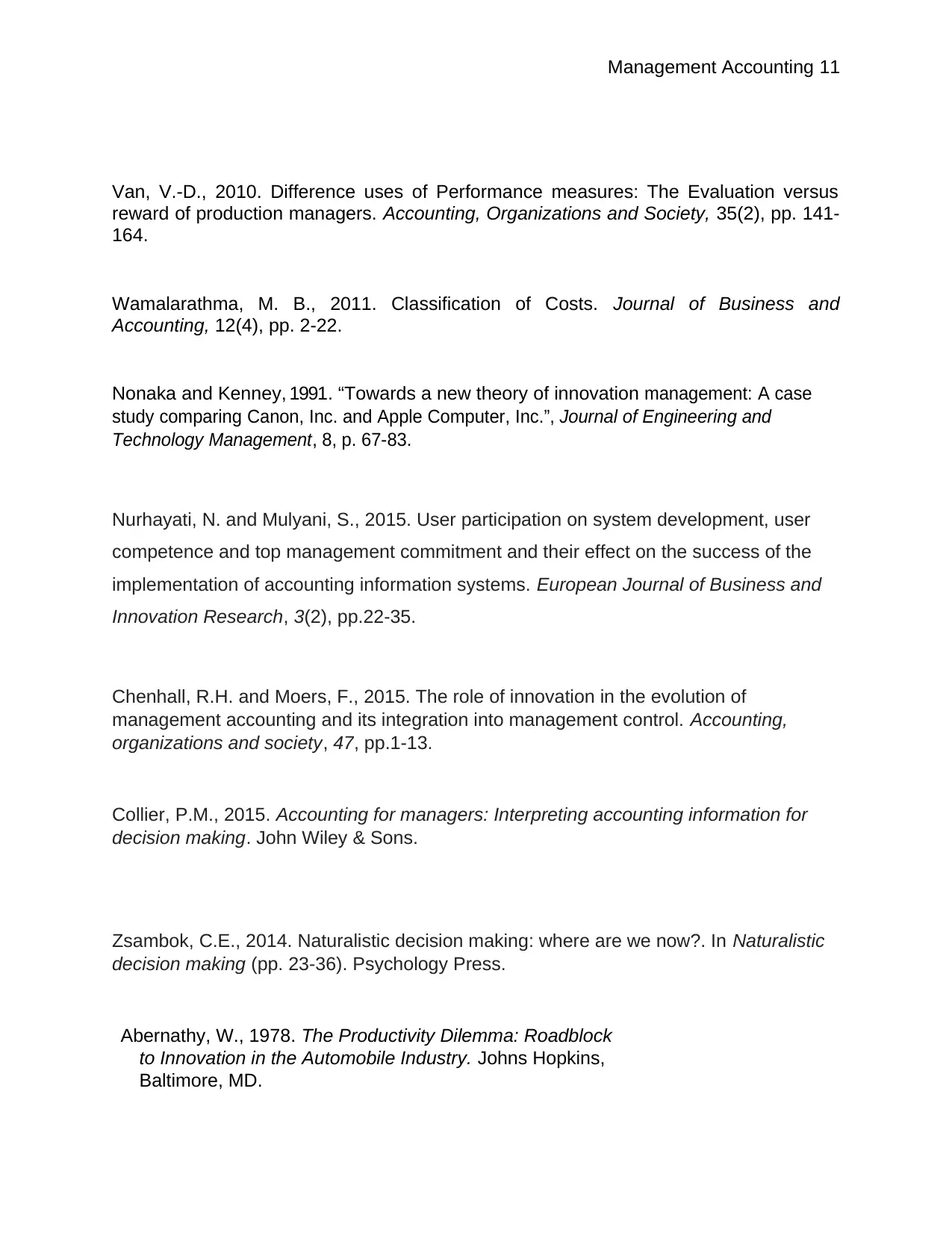
Management Accounting 11
Van, V.-D., 2010. Difference uses of Performance measures: The Evaluation versus
reward of production managers. Accounting, Organizations and Society, 35(2), pp. 141-
164.
Wamalarathma, M. B., 2011. Classification of Costs. Journal of Business and
Accounting, 12(4), pp. 2-22.
Nonaka and Kenney, 1991. “Towards a new theory of innovation management: A case
study comparing Canon, Inc. and Apple Computer, Inc.”, Journal of Engineering and
Technology Management, 8, p. 67-83.
Nurhayati, N. and Mulyani, S., 2015. User participation on system development, user
competence and top management commitment and their effect on the success of the
implementation of accounting information systems. European Journal of Business and
Innovation Research, 3(2), pp.22-35.
Chenhall, R.H. and Moers, F., 2015. The role of innovation in the evolution of
management accounting and its integration into management control. Accounting,
organizations and society, 47, pp.1-13.
Collier, P.M., 2015. Accounting for managers: Interpreting accounting information for
decision making. John Wiley & Sons.
Zsambok, C.E., 2014. Naturalistic decision making: where are we now?. In Naturalistic
decision making (pp. 23-36). Psychology Press.
Abernathy, W., 1978. The Productivity Dilemma: Roadblock
to Innovation in the Automobile Industry. Johns Hopkins,
Baltimore, MD.
Van, V.-D., 2010. Difference uses of Performance measures: The Evaluation versus
reward of production managers. Accounting, Organizations and Society, 35(2), pp. 141-
164.
Wamalarathma, M. B., 2011. Classification of Costs. Journal of Business and
Accounting, 12(4), pp. 2-22.
Nonaka and Kenney, 1991. “Towards a new theory of innovation management: A case
study comparing Canon, Inc. and Apple Computer, Inc.”, Journal of Engineering and
Technology Management, 8, p. 67-83.
Nurhayati, N. and Mulyani, S., 2015. User participation on system development, user
competence and top management commitment and their effect on the success of the
implementation of accounting information systems. European Journal of Business and
Innovation Research, 3(2), pp.22-35.
Chenhall, R.H. and Moers, F., 2015. The role of innovation in the evolution of
management accounting and its integration into management control. Accounting,
organizations and society, 47, pp.1-13.
Collier, P.M., 2015. Accounting for managers: Interpreting accounting information for
decision making. John Wiley & Sons.
Zsambok, C.E., 2014. Naturalistic decision making: where are we now?. In Naturalistic
decision making (pp. 23-36). Psychology Press.
Abernathy, W., 1978. The Productivity Dilemma: Roadblock
to Innovation in the Automobile Industry. Johns Hopkins,
Baltimore, MD.
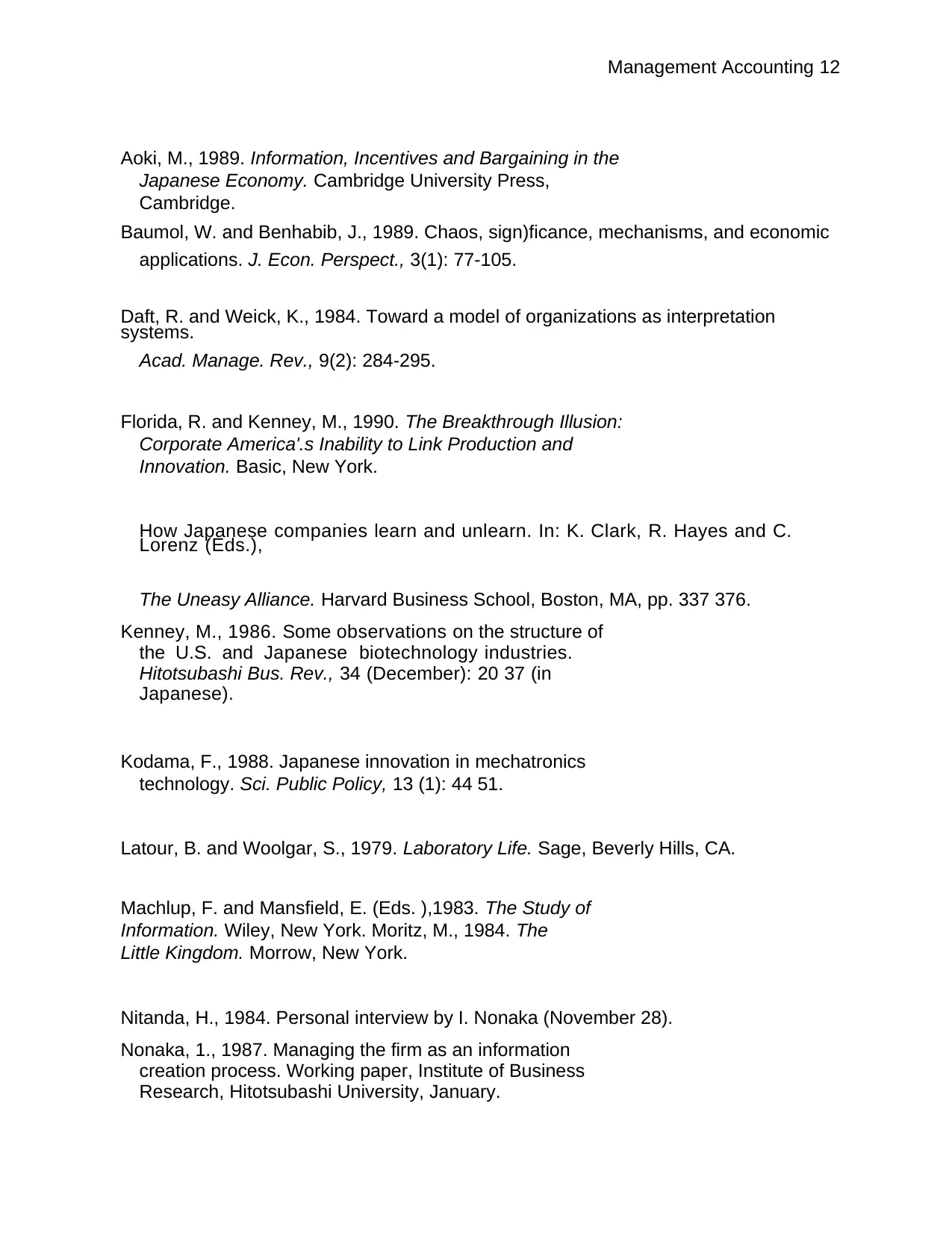
Management Accounting 12
Aoki, M., 1989. Information, Incentives and Bargaining in the
Japanese Economy. Cambridge University Press,
Cambridge.
Baumol, W. and Benhabib, J., 1989. Chaos, sign)ficance, mechanisms, and economic
applications. J. Econ. Perspect., 3(1): 77-105.
Daft, R. and Weick, K., 1984. Toward a model of organizations as interpretation
systems.
Acad. Manage. Rev., 9(2): 284-295.
Florida, R. and Kenney, M., 1990. The Breakthrough Illusion:
Corporate America'.s Inability to Link Production and
Innovation. Basic, New York.
How Japanese companies learn and unlearn. In: K. Clark, R. Hayes and C.
Lorenz (Eds.),
The Uneasy Alliance. Harvard Business School, Boston, MA, pp. 337 376.
Kenney, M., 1986. Some observations on the structure of
the U.S. and Japanese biotechnology industries.
Hitotsubashi Bus. Rev., 34 (December): 20 37 (in
Japanese).
Kodama, F., 1988. Japanese innovation in mechatronics
technology. Sci. Public Policy, 13 (1): 44 51.
Latour, B. and Woolgar, S., 1979. Laboratory Life. Sage, Beverly Hills, CA.
Machlup, F. and Mansfield, E. (Eds. ),1983. The Study of
Information. Wiley, New York. Moritz, M., 1984. The
Little Kingdom. Morrow, New York.
Nitanda, H., 1984. Personal interview by I. Nonaka (November 28).
Nonaka, 1., 1987. Managing the firm as an information
creation process. Working paper, Institute of Business
Research, Hitotsubashi University, January.
Aoki, M., 1989. Information, Incentives and Bargaining in the
Japanese Economy. Cambridge University Press,
Cambridge.
Baumol, W. and Benhabib, J., 1989. Chaos, sign)ficance, mechanisms, and economic
applications. J. Econ. Perspect., 3(1): 77-105.
Daft, R. and Weick, K., 1984. Toward a model of organizations as interpretation
systems.
Acad. Manage. Rev., 9(2): 284-295.
Florida, R. and Kenney, M., 1990. The Breakthrough Illusion:
Corporate America'.s Inability to Link Production and
Innovation. Basic, New York.
How Japanese companies learn and unlearn. In: K. Clark, R. Hayes and C.
Lorenz (Eds.),
The Uneasy Alliance. Harvard Business School, Boston, MA, pp. 337 376.
Kenney, M., 1986. Some observations on the structure of
the U.S. and Japanese biotechnology industries.
Hitotsubashi Bus. Rev., 34 (December): 20 37 (in
Japanese).
Kodama, F., 1988. Japanese innovation in mechatronics
technology. Sci. Public Policy, 13 (1): 44 51.
Latour, B. and Woolgar, S., 1979. Laboratory Life. Sage, Beverly Hills, CA.
Machlup, F. and Mansfield, E. (Eds. ),1983. The Study of
Information. Wiley, New York. Moritz, M., 1984. The
Little Kingdom. Morrow, New York.
Nitanda, H., 1984. Personal interview by I. Nonaka (November 28).
Nonaka, 1., 1987. Managing the firm as an information
creation process. Working paper, Institute of Business
Research, Hitotsubashi University, January.
⊘ This is a preview!⊘
Do you want full access?
Subscribe today to unlock all pages.

Trusted by 1+ million students worldwide
1 out of 13
Related Documents
Your All-in-One AI-Powered Toolkit for Academic Success.
+13062052269
info@desklib.com
Available 24*7 on WhatsApp / Email
![[object Object]](/_next/static/media/star-bottom.7253800d.svg)
Unlock your academic potential
Copyright © 2020–2025 A2Z Services. All Rights Reserved. Developed and managed by ZUCOL.





